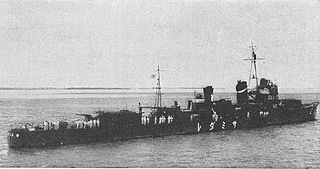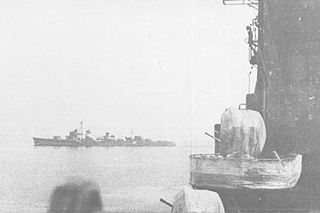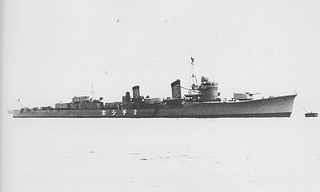
Minegumo was the eighth of ten Asashio-class destroyers built for the Imperial Japanese Navy in the mid-1930s under the Circle Two Supplementary Naval Expansion Program.

Samidare was the fifth of ten Shiratsuyu-class destroyers, built for the Imperial Japanese Navy under the Circle One Program.

Asagumo was the fifth of ten Asashio-class destroyers built for the Imperial Japanese Navy in the mid-1930s under the Circle Two Supplementary Naval Expansion Program.

Harusame was the sixth of ten Shiratsuyu-class destroyers, and was built for the Imperial Japanese Navy under the "Circle One" Program. This vessel should not be confused with the earlier Russo-Japanese War-period Harusame-class torpedo boat destroyer with the same name.

Hayashio was the fifth vessel to be commissioned in the 19-vessel Kagerō-class destroyers built for the Imperial Japanese Navy in the late-1930s under the Circle Three Supplementary Naval Expansion Program.

Hatsukaze was the seventh vessel to be commissioned in the 19-vessel Kagerō-class destroyers built for the Imperial Japanese Navy in the late-1930s under the Circle Three Supplementary Naval Expansion Program. She survived four major fleet actions against the Allies, helping to sink the submarine USS Perch and the torpedo boats PT-43 and PT-112 throughout her career but, after being damaged through a collision with the Japanese heavy cruiser Myōkō. she was sunk by an American destroyer flotilla led by Captain Arleigh Burke aboard USS Charles Ausburne at the battle of the Empress August Bay, November 2 1943.

Kuroshio was the third vessel to be commissioned in the 19-vessel Kagerō-class destroyers built for the Imperial Japanese Navy in the late-1930s under the Circle Three Supplementary Naval Expansion Program.

Oyashio was the fourth vessel to be commissioned in the 19-vessel Kagerō-class destroyers built for the Imperial Japanese Navy in the late 1930s under the Circle Three Supplementary Naval Expansion Program.

Kagerō was the lead ship of the 19-vessel Kagerō-class destroyers built for the Imperial Japanese Navy in the late-1930s under the Circle Three Supplementary Naval Expansion Program.
Shigure was the second of ten Shiratsuyu-class destroyers, and the first to be built for the Imperial Japanese Navy under the Circle One Program. Along with the destroyer Yukikaze, she developed a reputation within the Imperial Japanese Navy for being "lucky" or "unsinkable", emerging undamaged from several battles and as the sole surviving Japanese warship from two. As the flagship of Captain Tameichi Hara's Destroyer Division 27 Shigure received a prominent place in the memoirs of the only Japanese destroyer captain to survive the entire Pacific War and write about his experiences. Shigure was torpedoed and sunk by the submarine USS Blackfin in the Gulf of Siam on 24 January 1945.

Umikaze was the seventh of ten Shiratsuyu-class destroyers, and the first to be built for the Imperial Japanese Navy under the Circle Two Program. A U.S. Navy submarine torpedoed and sunk her on 1 February 1944, off Truk Atoll.

Suzukaze was the tenth and final vessel of ten Shiratsuyu-class destroyers, and the fourth to be built for the Imperial Japanese Navy under the Circle Two Program.

Shiratsuyu was the lead ship of ten Shiratsuyu-class destroyers, and first of six to be built for the Imperial Japanese Navy under the Circle One Program.

Yūgure was the sixth and last Hatsuharu-class destroyer, built for the Imperial Japanese Navy under the Circle One Program. Three were laid down in JFY 1931 and the next three in JFY 1933.

Michishio was the third of ten Asashio-class destroyers built for the Imperial Japanese Navy in the mid-1930s under the Circle Two Supplementary Naval Expansion Program.

Arashio was the fourth of ten Asashio-class destroyers built for the Imperial Japanese Navy in the mid-1930s under the Circle Two Supplementary Naval Expansion Program.

Kasumi was the ninth of ten Asashio-class destroyers built for the Imperial Japanese Navy in the mid-1930s under the Circle Two Supplementary Naval Expansion Program.

Yamagumo was the sixth of ten Asashio-class destroyers built for the Imperial Japanese Navy in the mid-1930s under the Circle Two Supplementary Naval Expansion Program.

Arare was the tenth and last of the Asashio-class destroyers built for the Imperial Japanese Navy in the mid-1930s under the Circle Two Supplementary Naval Expansion Program.

Asashio was the lead ship of the ten Asashio-class destroyers built for the Imperial Japanese Navy in the mid-1930s under the Circle Two Program.



















